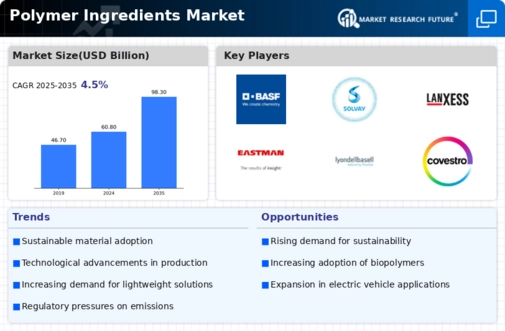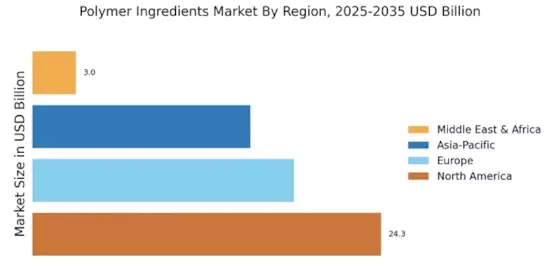Rising Demand for Eco-Friendly Products
The Polymer Ingredients Market experiences a notable increase in demand for eco-friendly products. As consumers become more environmentally conscious, manufacturers are compelled to innovate and develop sustainable polymer solutions. This shift is reflected in the growing market for biodegradable polymers, which is projected to reach USD 6.5 billion by 2025. Companies are investing in research and development to create materials that minimize environmental impact while maintaining performance. The emphasis on sustainability not only aligns with consumer preferences but also meets regulatory requirements, further driving growth in the Polymer Ingredients Market. This trend suggests a potential for significant market expansion as businesses adapt to these changing dynamics.
Expanding Applications Across Industries
The Polymer Ingredients Market is witnessing an expansion of applications across various sectors, including automotive, construction, and healthcare. The automotive industry, in particular, is increasingly utilizing polymers for lightweight components, which enhance fuel efficiency and reduce emissions. The demand for polymer-based materials in construction is also on the rise, driven by the need for durable and energy-efficient building solutions. According to industry estimates, the construction sector's consumption of polymers is projected to grow by 4.5% annually. This diversification of applications indicates a robust growth trajectory for the Polymer Ingredients Market, as it adapts to the evolving needs of multiple sectors.
Increased Investment in Research and Development
Investment in research and development is a key driver for the Polymer Ingredients Market. Companies are allocating substantial resources to innovate and improve polymer formulations, focusing on enhancing performance characteristics such as strength, flexibility, and thermal stability. This trend is particularly evident in the development of high-performance polymers, which are gaining traction in demanding applications like aerospace and electronics. The market for high-performance polymers is anticipated to grow significantly, with projections indicating a value of USD 30 billion by 2025. Such investments not only foster innovation but also position companies competitively within the Polymer Ingredients Market.
Regulatory Pressures and Compliance Requirements
Regulatory pressures and compliance requirements are increasingly influencing the Polymer Ingredients Market. Governments worldwide are implementing stricter regulations regarding the use of certain chemicals and materials, prompting manufacturers to adapt their processes and product offerings. Compliance with these regulations often necessitates the development of safer and more sustainable polymer ingredients. This shift is likely to drive innovation as companies seek to meet regulatory standards while maintaining product performance. The market for compliant polymer solutions is expected to grow, reflecting the industry's response to these evolving regulatory landscapes. This dynamic suggests that regulatory factors will continue to play a pivotal role in shaping the Polymer Ingredients Market.
Technological Advancements in Polymer Production
Technological advancements play a crucial role in shaping the Polymer Ingredients Market. Innovations in polymerization techniques and processing technologies enhance the efficiency and quality of polymer production. For instance, the adoption of advanced catalysts and automation in manufacturing processes has led to increased output and reduced production costs. The market for specialty polymers, which are often produced using these advanced techniques, is expected to grow at a compound annual growth rate of 5.2% through 2025. These advancements not only improve product performance but also enable manufacturers to meet diverse customer needs, thereby fostering growth in the Polymer Ingredients Market.


















Leave a Comment